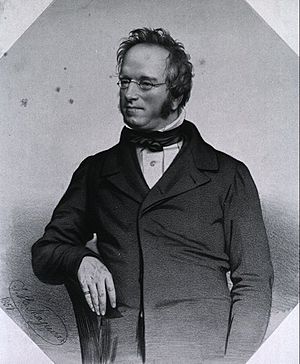John Edward Gray facts for kids
Quick facts for kids
John Edward Gray
|
|
|---|---|
 |
|
| Born | 12 February 1800 Walsall, England
|
| Died | 7 March 1875 (aged 75) London, England
|
| Resting place | St Mary's Church, Lewisham |
| Known for | Classification of many cetacean species, genera, subfamilies, and families |
| Spouse(s) | |
| Parent(s) | Samuel Frederick Gray |
| Relatives | George Robert Gray (brother) |
| Scientific career | |
| Fields | Zoology |
| Institutions | British Museum, Natural History Museum |
| Influenced | Eliza Fanny Staveley |
| Author abbrev. (botany) | J.E.Gray |
| Author abbrev. (zoology) | Gray or J. E. Gray |
| Signature | |
John Edward Gray (born February 12, 1800 – died March 7, 1875) was an important British zoologist. A zoologist is a scientist who studies animals. He was a member of the Royal Society, a famous group for scientists.
John Edward Gray came from a family of scientists. His older brother, George Robert Gray, was also a zoologist. His father, Samuel Frederick Gray, studied plants and medicines. John Edward Gray worked at the British Museum in London. He was the Keeper of Zoology from 1840 until 1874. This means he was in charge of the animal collections. He helped make the museum's animal collections some of the best in the world.
Contents
Early Life and Career
John Edward Gray was born in Walsall, England. His family moved to London when he was young. There, he studied medicine. He helped his father write a book about British plants.
At first, Gray was very interested in plants. But then he changed his focus to animals. When he was just 15, he started helping the British Museum. He volunteered to collect insects for them. In 1824, he officially joined the museum's Zoological Department. He helped organize their collection of reptiles.
Gray became the Keeper of Zoology in 1840. He held this important job for 35 years. During this time, he wrote more than 1,000 scientific papers. He named many different kinds of cetaceans. Cetaceans are sea mammals like whales and dolphins. He also named many new species and groups of animals.
Working with Others
Gray worked with many other scientists and artists. He collaborated with Benjamin Waterhouse Hawkins. Hawkins was a famous artist who drew animals. They worked together on a book called Gleanings from the Menagerie at Knowsley. This book showed animals from a very large private zoo. This zoo was at Knowsley Hall near Liverpool.
In 1826, Gray married Maria Emma Smith. She was also interested in science. She helped him with his work, especially by drawing pictures of animals.
Gray was also a founder of the Royal Entomological Society in 1833. This society is for people who study insects. He was friends with Hamlet Clark, who studied beetles. In 1856, they sailed together on Gray's yacht to Spain, Algeria, and Brazil. Gray was a good painter and drew landscapes during their trips.
Other Interests and Contributions
John Edward Gray had many interests. He was also interested in postage stamps. On May 1, 1840, he bought some of the very first Penny Black stamps. These were the world's first adhesive postage stamps. He bought them to save them. This makes him one of the first known stamp collectors!
During his 50 years at the British Museum, Gray wrote almost 500 papers. Many of these papers described new animal species. These animals were sent to the museum by collectors from all over the world. He studied all kinds of animals. However, he often let his younger brother George describe new birds.
Gray also studied molluscs, which are soft-bodied animals like snails and clams. He supported the research of Eliza Fanny Staveley, an entomologist. He even read her papers for her at scientific meetings.
John Edward Gray was buried at St Mary's Church in Lewisham.
Animals Named by and for John Edward Gray
Gray was one of the most active scientists in naming animals. He described over 300 species and subspecies of reptiles. This was a huge number for his time!
Here are some animal groups he named:
- The snail group Lithopoma (named in 1850)
- The snail group Euthria (named in 1850)
Many animals were also named in his honor:
- The snake group Grayia
- The Indian pond heron (Ardeola grayii)
- Gray's beaked whale (Mesoplodon grayi)
- Luzon shrew (Crocidura grayi)
- The Northland green gecko (Naultinus grayii)
- Gray's char (Salvelinus grayi), a type of fish
- Gray's pipefish (Halicampus grayi), a type of fish
See also
 In Spanish: John Edward Gray para niños
In Spanish: John Edward Gray para niños
- "The New Museum Idea"


